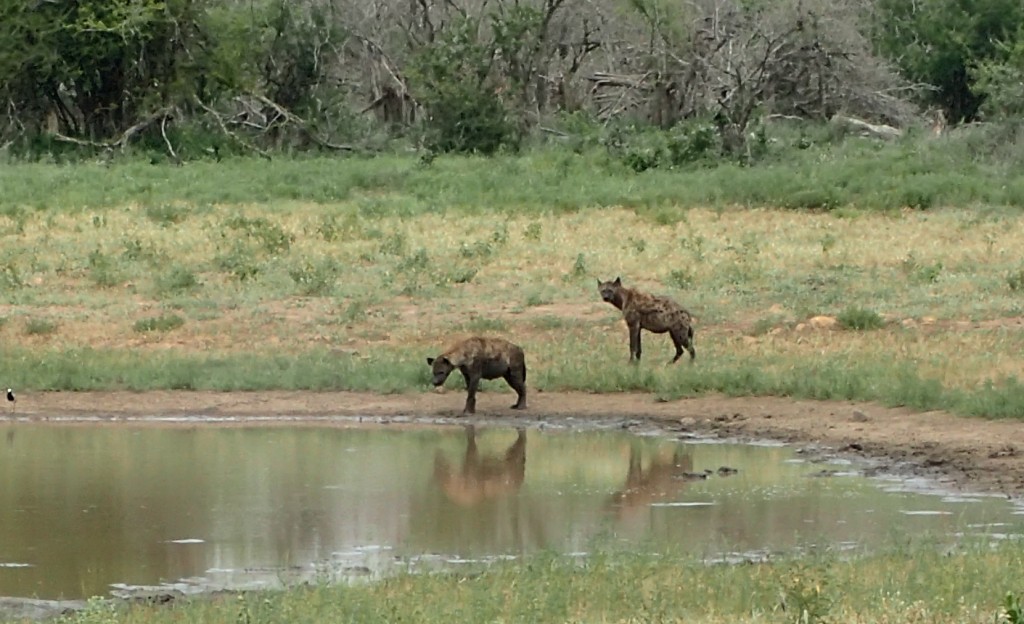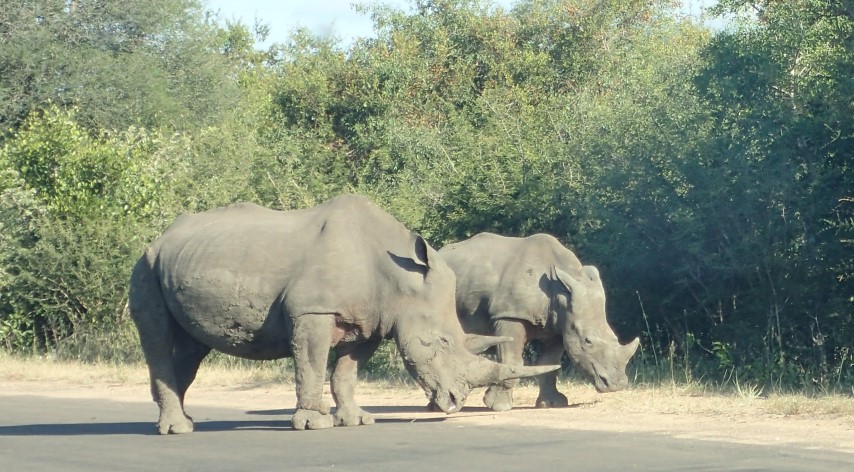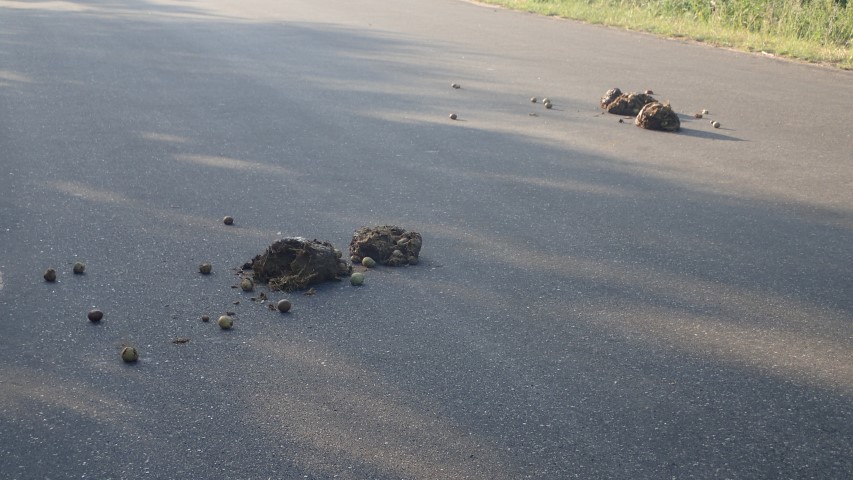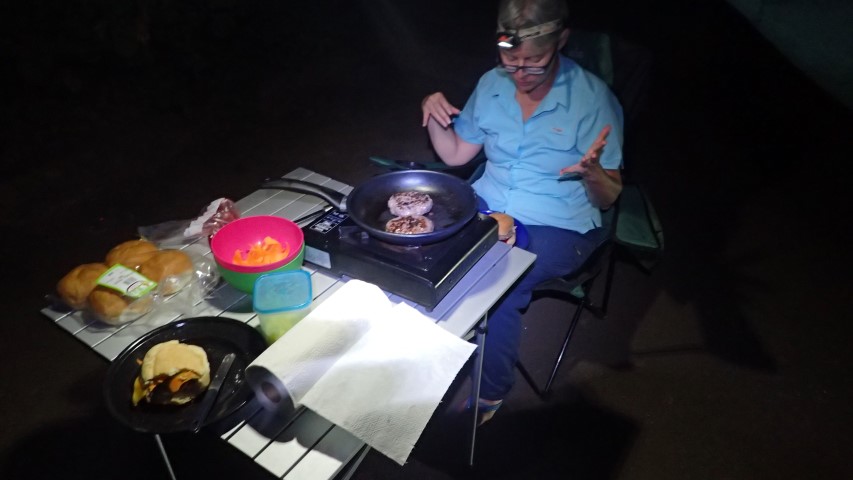Wildlife tally for Tuesday Feb 3
elephants
giraffes
antelopey thingies – impala and waterbuck, plus a couple of new additions to the list below
blue wildebeest
buffalo
mongoose
baboons
New to our list today
guinea fowl
duiker – a little antelope with very delicate features and tiny horns
springbok – we realise that we’ve probably seen lots of these before and thought they were impala. Springbok have straight antlers that curve at the end. Impala have antlers that twist. In case you were wondering.
vultures – we think a group of vultures should be called a ‘death-watch’. According to wikipedia, it’s a wake, committee, venue, kettle, or volt. ‘Wake’ is pretty good, but I still like our ‘death-watch’ the best.
African wild dogs. We saw a pair of them at a waterhole and got pretty excited. They are rare here, according to wikipedia, in 2009 there were only about 150 in the whole of Kruger.
Number 1 spot must go to the pair of rhinos we saw on our way to Lower Sabie campground yesterday afternoon. I hadn’t really thought we’d be lucky enough to see any here, but this mother and son pair just wandered onto the road we were driving along. They stood there for a couple of minutes while we got all excited and took photos and a video, then they wandered off into the scrub. If we had been just a couple of minutes later, we would never have known they had been there. Rhinos are HUGE! Much larger than I thought they would be.
We’re now in the southern part of Kruger, staying at Lower Sabie campground. Lots more people in this part of the park – campers, tourists, tour buses, sightseers. We drove from the park’s main campground & administration centre Skukuza yesterday afternoon and that was when we saw most of the animals on the list above. We’ve decided that late afternoon drives are the most worthwhile as that’s when the wildlife is out and about. On that same stretch of road, we saw some elephant dung on the road, with lots of whole, unripe marula in it, and a bit further down the road we found the elephant! Wandering all over the road, picking at bits of shrub then dropping then, a bit unsure of where he was going next. We just sat and waited until it was safe to pass him. In the comments section of the Satara Rest Camp post, our friend Hazel warned us about marula-eating elephants, and we’ve seen a youtube video of an elephant destroying a car in Kruger, and didn’t want a repeat of that.
Dinner last night was springbok burgers that we bought from the well-stocked shop at Skukuza. 4 burger patties cost us less than $5. We could also have had warthog fillet, various antelopey-thingie sausages and a variety of other game meat choices, in addition to beef, chicken, lamb and pork. Tonight we’re thinking of cooking some kind of boerwors (long sausage that’s curled into a circle) on a braai, as long as we can get some firewood. We’ll share photos, of course.
The rental car company, Avis, has given us permission to take the car into Swaziland, so we’re heading there tomorrow for a couple of days. We have used Avis for our last few trips and they have alway been very helpful, and even replaced the car when we (and they) couldn’t get a tyre to replace the one that got wrecked while we were driving in Oslo.
I know almost nothing about Swaziland, apart from what I read in Richard E Grant’s book The Wah Wah Diaries, about making his autobiographical movie, Wah Wah. There are a couple of national parks and we’ll camp somewhere. The capital, Mbabane, has a population of 60,000, Swaziland is a landlocked country, sharing borders with Mozambique and South Africa. They have their own currency, but the South African rand is accepted there, which we’re happy about as we won’t have to exchange any money. I went into a bank yesterday clutching a wad of Botswana pula, hoping to exchange them into rand. The teller almost shooed me out, so we’re going to try at Joburg airport. I now know that the rand is accepted in Namibia, Botswana, Lesotho, Swaziland and of course South Africa. Various travel sites also claim that it’s accepted in Zimbabwe, which may be true outside of Victoria Falls, but at Vic Falls it’s USD all the way. Which seems odd when the US has trade sanctions against Zim.





Such an interesting post Jude . Strange that they wouldn’t take the Pula when Botswana has a reasonably good economy .
I hope Swaziland is safe and the roads are acceptable x
Thanks Sal. I think my expectations of a bank in Kruger exchanging our pula were a bit high. They probably only offer to exchange foreign (ie- USD, GBP, euro, yen etc) currency for the tourists who fly in and fly out, ‘cos that campground/admin centre may be their first (and sometimes only) stop in Sth Africa.
What a great recap of the travels today. Fascinating stuff!
So was the elephant under the influence?
Maybe a decay of vultures.
Pardon my ignorance but are wild dogs Hyenas or is there a difference?
We think he may have been a teensy bit tipsy, Char. I do like decay of vultures. Will try and use that in a sentence sometime. We keep seeing large birds hovering overhead, but can’t work out if they are vultures or eagles.
No, wild dogs and hyenas are different. Haven’t seen any hyenas yet, but the dogs we saw looked like small wolves, whereas I think hyenas are slighter in form
Sorry I think Char is right the wild dogs are Hyenas but I could be proven wrong which has happened to me before.
Nope, hyenas are different. One of our guide book has photos of 2 types of hyena – the Spotted Hyena and the brown hyena, which do look a bit loke dogs, but the African Wild Dog is a separate animal and much more ‘wolf-like’. Sorry, not enough internet data left to go and do a search.
Your wild dogs look more like hyenas to me – wild dogs (Cape Hunting Dogs) in Kruger have big ears and don’t have the sloping back of hyenas. (There’s a Cape Hunting Dog in Kruger called ‘Hazel’ after me – he turned out to be a bloke!! I gave them some money towards an electric fence.)
Ah, thanks for that Hazel. We’d better strike the wild dogs off our list and add hyena to it. We thought we hadn’t seen any hyenas.